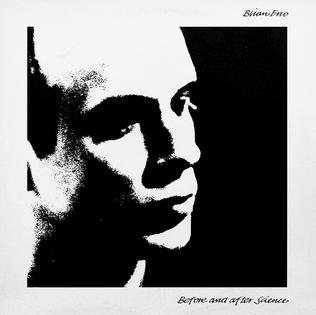
Before and After Science
Before and After Science is the fifth solo studio album by Brian Eno, originally released by Polydor Records in December 1977 in the United Kingdom and by Island U.S. soon after. Produced by Eno and Rhett Davies, it is the first of Eno's popular music works to be published under his full name (unlike all recordings that preceded the record and Discreet Music, where he was mononymously credited as "Eno").
Before and After Science
Musicians from the United Kingdom and Germany had notably collaborated on the album, including Robert Wyatt, Fred Frith, Phil Manzanera, Paul Rudolph, Andy Fraser, Dave Mattacks, Jaki Liebezeit, Dieter Moebius, and Hans-Joachim Roedelius. Over one hundred tracks were written but only ten made the album's final cut. The musical styles range from energetic and jagged to languid and pastoral.
The album marks Eno's last foray into rock music as a solo artist in the 1970s, nearly all of his following work showcasing avant-garde and ambient music, which was hinted at predominantly on the second side of Before and After Science. It was Eno's second to chart in the United States. The song "King's Lead Hat", the title of which is an anagram for Talking Heads, was remixed and released as a single, although it did not chart in the United Kingdom. Critical response to the album has remained positive, several critics calling it one of Eno's best works.
Production[edit]
Unlike Eno's previous albums, which were recorded in a very short time, Before and After Science was two years in the making.[6] During this two-year period, Eno was busy working on his solo ambient music albums Music for Films and Discreet Music.[6] Due to the very positive critical reception accorded his previous rock music-oriented album, Another Green World, Eno was afraid of repeating himself but still wanted to release a high-quality product.[6]
As on his previous rock-based recordings, Eno worked with a plethora of guest musicians. Several artists from German and British groups of the era contributed to the album, collaborating with Eno for the first time. Guitarist Fred Frith caught Eno's attention with "the timbral possibilities that [Frith had] been discovering" on his album Guitar Solos.[7] Jaki Liebezeit of the German krautrock group Can played drums on "Backwater", and German ambient music group Cluster contributed to the songwriting and instrumentation of the track "By This River".[1][8] Eno had previously worked with Cluster on their album Cluster & Eno, released in 1977.[9] Other musicians included Dave Mattacks, who played drums on "Kurt's Rejoinder" and "Here He Comes", and Andy Fraser (normally a bass guitarist in British blues rock band Free) who played the drums on "King's Lead Hat".[1][10][11]
Several musicians who had worked with Eno on previous albums returned. Percy Jones of Brand X and Phil Collins of Genesis played bass and drums respectively.[8] Other returning contributors included Robert Fripp, Paul Rudolph, Bill MacCormick and Phil Manzanera.[12] "Shirley Williams" is credited on the album sleeve for "time" and "brush timbales" on "Through Hollow Lands" and "Kurt's Rejoinder"; Williams was a pseudonym for Robert Wyatt.[13] Working extensively with the musicians and his instructional cards—the Oblique Strategies—during the two years working on the album, Eno wrote over one hundred songs.[1][6][14]
Music and lyrics[edit]
Jim DeRogatis, author of Turn on Your Mind: Four Decades of Great Psychedelic Rock, described the overall sound of Before and After Science as "the coldest and most clinical of Eno's pop efforts".[15] David Ross Smith of online music database AllMusic wrote that "Despite the album's pop format, the sound is unique and strays far from the mainstream".[8] According to David Bowie's biographer Thomas Jerome Seabrook, the album is "split between up-tempo art-rock on side one and more pastoral material on side two",[2] while Piotr Orlov of LA Weekly categorized it as an art pop record.[3] The album's opening tracks "No One Receiving" and "Backwater" start the album as upbeat and bouncy songs.[8] "King's Lead Hat" is an anagram of Talking Heads, a new wave group Eno had met after a concert in England when they were touring with Ramones.[16][17] Eno would later produce Talking Heads' second, third and fourth albums, including Remain in Light.[18] The last five songs of the album have been described as having "an occasional pastoral quality" and being "pensive and atmospheric".[8]
Eno referred to the music of Before and After Science as "ocean music", as opposed to Another Green World', which he described as "sky music".[14] References to water in the lyrics appear in songs such as "Backwater", "Julie With..." and "By this River".[19] Author Simon Reynolds noted themes of "boredom" and "bliss" through the album, citing "Here He Comes", about "a boy trying to vanish by floating through the sky through a different time" and "Spider and I", about a boy watching the sky and dreaming about being carried away with a ship, as examples.[19] Eno's songwriting style was described as "a sound-over-sense approach".[8] Influenced by poet Kurt Schwitters, Eno consciously did not make songwriting or lyrics the main focus in the music.[8] Tom Carson of Rolling Stone noted this style, stating that the lyrics are "only complementary variables" to the music on the album.[20] Lester Bangs commented on Eno's lyrical style on "Julie with..." stating that the lyrics' themes "could be a murderer's ruminations, or simply a lovers' retreat... or Julie could be three years old".[14] Schwitters' influence is also shown on the song "Kurt's Rejoinder", on which samples of Schwitters' poem "Ursonate" can be heard.[8][16]